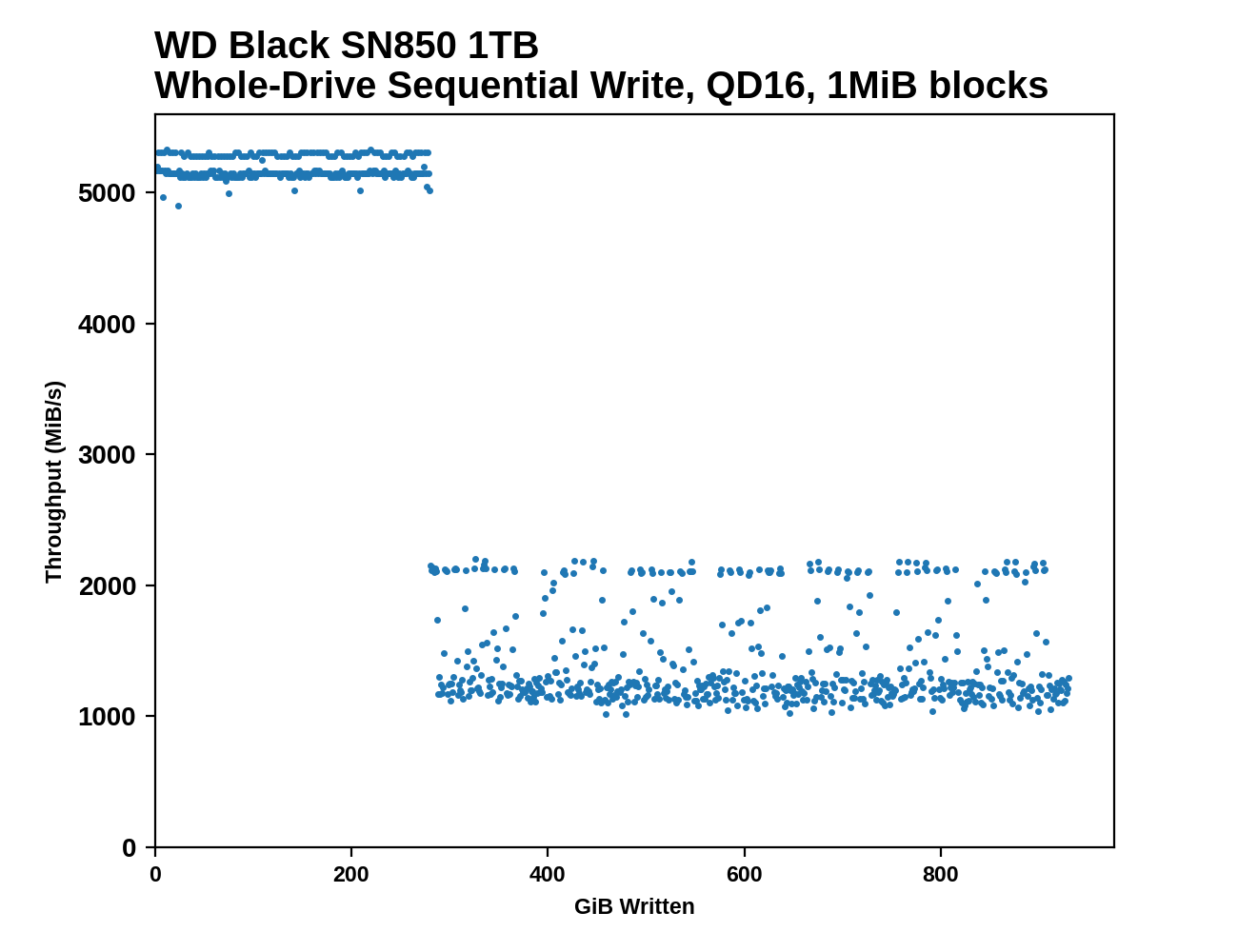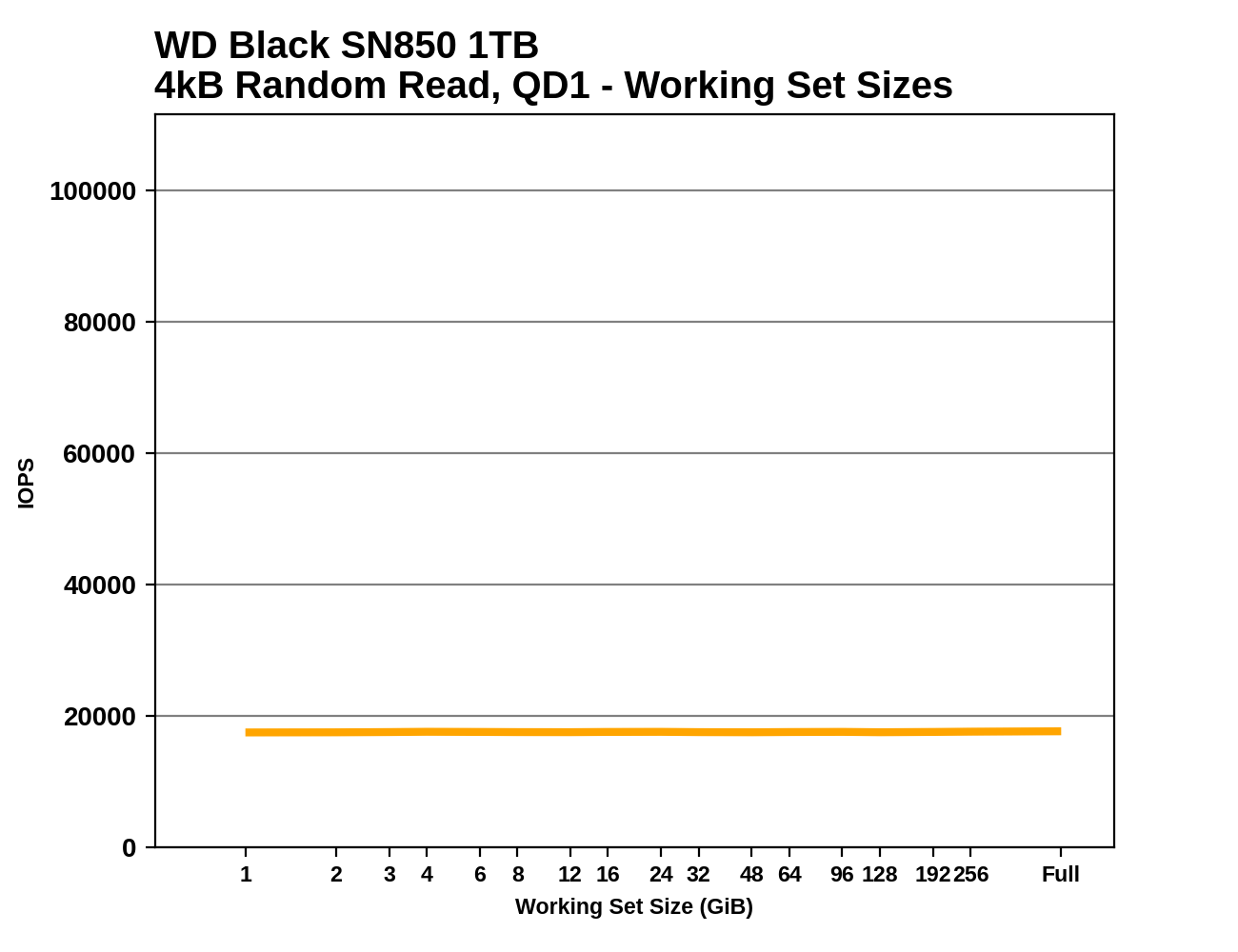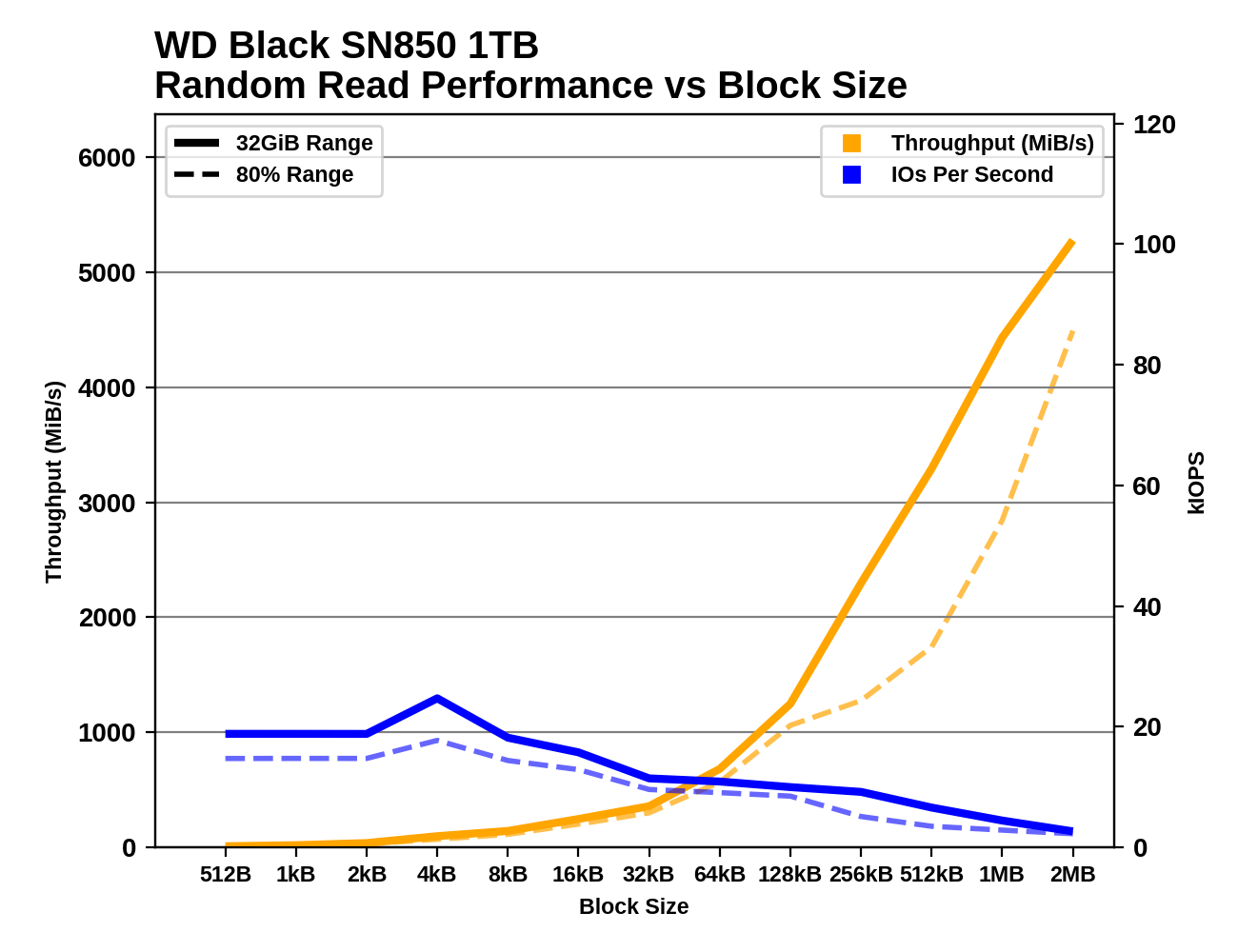The Western Digital WD Black SN850 Review: A Very Fast PCIe 4.0 SSD
by Billy Tallis on March 18, 2021 12:50 PM ESTAdvanced Synthetic Tests
Our benchmark suite includes a variety of tests that are less about replicating any real-world IO patterns, and more about exposing the inner workings of a drive with narrowly-focused tests. Many of these tests will show exaggerated differences between drives, and for the most part that should not be taken as a sign that one drive will be drastically faster for real-world usage. These tests are about satisfying curiosity, and are not good measures of overall drive performance. For more details, please see the overview of our 2021 Consumer SSD Benchmark Suite.
Whole-Drive Fill
 |
|||||||||
| Pass 1 | |||||||||
| Pass 2 | |||||||||
On the first pass starting from an empty drive, the WD Black SN850's SLC cache handles sequential writes at a bit over 5GB/s and the cache lasts for about 281GB before running out. That's a very large SLC cache size for a TLC drive, which is probably why performance is so variable after the cache is full. For the second pass of sequential writes, the cache size has been reduced to about 20GB, but the drive shows a second burst of 20GB of SLC-speed writes later in the test.
 |
|||||||||
| Average Throughput for last 16 GB | Overall Average Throughput | ||||||||
The aggressive SLC caching behavior on the SN850 comes at the cost of slower and less-consistent post-cache write performance, but Western Digital's earlier WD Black SSDs already behaved quite well here. The SN850 manages to keep write speed from ever dropping below 1GB/s, and the overall average across the entire drive fill is basically the same as the SN730, the OEM relative to the SN750 but with the same newer flash as the SN850.
On the second sequential write pass when the SN850's variable-size SLC cache is already at its smallest, post-cache performance is extremely consistent and faster than any other TLC SSD we have tested, but still 15% slower than the MLC-based Samsung 970 PRO.
Working Set Size
 |
|||||||||
Most high-end drives have boring and steady results on this test since they don't skimp on DRAM. The QD1 random read latency for the SN850 is better than any other TLC drive we've tested, and only 4% slower than the MLC-based Samsung 970 PRO.
Performance vs Block Size
 |
|||||||||
| Random Read | |||||||||
| Random Write | |||||||||
| Sequential Read | |||||||||
| Sequential Write | |||||||||
The WD Black SN850 is strongly optimized for 4kB IOs, with lower IOPS and throughput for sub-4kB block sizes on all four workloads. None of the other drives show such broad preferences for 4kB block sizes, but some of Western Digital's drives and a few others show this behavior on at least some of the workloads. This tuning pays off in some places, such as the SN850's leading random write performance for small block sizes (which is followed by the SLC cache running out while testing larger block random writes). There are some other weaknesses including poor performance for small-block sequential reads, but more importantly it has great performance for sequential reads with larger block sizes.










83 Comments
View All Comments
Billy Tallis - Friday, March 26, 2021 - link
A UPS vs power loss protection capacitors defend against slightly different sets of failure conditions, with a lot of overlap. A UPS will help save more data when the utility power goes out, but PLP caps will save data that a UPS couldn't if your PSU blows up or some other component failure inside the PC causes it to crash hard.wr3zzz - Friday, March 19, 2021 - link
Is there a benchmark that shows "real-world' performance are not worth the premium between PCIe 3.0 and PCIe 4.0? Like how it translates in terms of time saved. CPU benchmark for web page loading is a good example. The benchmark numbers might be 2x or 10x but it doesn't mean anything if it means 1 second vs. 0.1 second. On the other hand, the difference from HDD to SSD is from going minutes to seconds.The delta between 4.0 and 3.0 is so wide now. It doesn't do us any good by showing benchmark numbers that are 2x across the board between SN850 and SN750 but then recommend the value proposition just isn't there for PCIe 4.0 in the real world.
oRAirwolf - Friday, March 19, 2021 - link
I do agree that it would be nice if Anandtech would add some real world benchmarks to show use scenarios for the most common tasks like loading Windows, various video game load times, common program launching, etc. I have a very high-end rig but I still boot off of 3 x Samsung 850 evos in RAID 0 because as far as I can tell, there is no significant benefit to switching to an mvne drive for my use case of working from my desktop providing high level tech support and gaming.Oxford Guy - Sunday, March 21, 2021 - link
You should be able to compare the 'light' workload of 3.0 drives to the 'light' workload of 4.0 drives using their Bench comparison page.I'd pay particular attention to latency results. High latency can make things feel slow.
'The benchmark numbers might be 2x or 10x but it doesn't mean anything if it means 1 second vs. 0.1 second.'
Not true. .1 second latency (time to wake to do something) is a lot snappier than 1 second latency.
Morawka - Friday, March 19, 2021 - link
Excellent review. See if you guys can a Sabrent Rocket 4 Plus sample and do a review on it! It's supposedly a little faster that the WD 850 in synthetics, but perhaps a little slower in real-world usage. It will be a close match up, that's for sure.Billy Tallis - Friday, March 19, 2021 - link
I don't have a Rocket 4 Plus, but I have Micro Center's equivalent: Inland Performance Plus. It's currently running The Destroyer, and has already completed the synthetic tests. https://www.anandtech.com/bench/product/2732?vs=27...Oxford Guy - Sunday, March 21, 2021 - link
Glad to hear there is a firmware update. I wasn't sure that Inland drives would be eligible for them.Spunjji - Friday, March 19, 2021 - link
"MLC is now dead, and there's no compelling reason to bring it back"Oooof, that's gonna chafe the NAND conspiracy-theorists who frequent these hallowed comments 😅
Oxford Guy - Sunday, March 21, 2021 - link
3D fabrication made TLC viable. It has not remedied the deficiencies of QLC and now Intel is reportedly planning to push PLC onto consumers.There is nothing theoretical about:
• The fact that QLC only offers 30% more density, despite having a lot more voltage states than a 30% increase (diminished returns)
• QLC drives have not been priced low enough to make them worthwhile
• PLC is going to be worse
• Economy of scale is actively working against consumer value, by inflating the price of TLC
Failure of trolling noted.
FunBunny2 - Sunday, March 21, 2021 - link
"There is nothing theoretical about:"the fact that, what, no more than a handful make NAND. if they choose, whether through collusion or simultaneous profit-seeking, to sell only QLC and PLC what are you going to do about it? invoke the Defense Production Act to force SLC production at reduced prices? unfettered capitalism never favours the consumer.